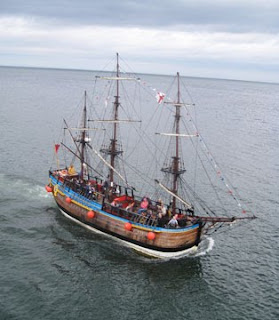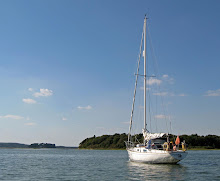A morning of exploration in Great Yarmouth and then a short hop down the coast to Lowestoft. The crew were less than complimentary about being berthed on the Town Quay at Yarmouth with its lack of facilities and wished to have a few more (some) mod cons (Showers).
Yarmouth Harbour is the river with quays along both banks. The Town Quay where we berthed is some 2 miles up stream. The main traffic today is supply boats for the north sea oil and gas rigs; it claims to be the largest supply boat port.
Herring has been a continuing factor in all the harbours visited down the eats coast from Lossimouth, in the Moray Firth, to Great Yarmouth and further south. Due to over fishing, the massive herring shoals along the north sea coast disappeared over the first decades of the 20th century and were almost extinct by the late 1930s. But the ‘silver darlings’ exerted a mighty pull. They dictated the migration of fishing fleets down the north sea as the boats and shoreworkers followed the shoals. In the autumn the herring ceased their southward journey off East Anglia and Great yarmouth and Lowestoft grew to accommodate the industry. Whilst it can be argued which port was the largest herring port, the vastness of the industry cannot be argued. Great Yarmouth accommodated over 1,000 herring boats in its heyday. Photographs of the boats arriving or departing give a whole new meaning to congestion. A herring drifter provided work for 100 people ashore gutting, filleting, salting and smoking. Trains arrived from Scotland bring the ‘herring girls ’ who followed the fish. It was a short but frantic season in Great Yarmouth from September to December. Sixty herrings a minute were gutted by one person working 14 hours a day.
Moored just astern of Alcyone was ‘Lydia Eva’, the last of the steam herring drifters. She was launched in 1933 and caught her last catch in 1938. Whilst looking old fashioned against today’s ships but she was very sophisticated in her day with electricity on board and wireless. A tour of the ship was thought provoking as to how sailors of that era lived and worked – Mathew was particularly taken with the idea that all the crew including Skipper lived in a single cabin and only had straw palliasse to sleep on and no washing or toilet facilities.
Our wandering us the took us through the Historic South Quay to the Herring Museum and Time and Tide Museum. Both have been built into old herring smokeries and told the story of the herring industry. One could peer up into the rafters at the smoking racks with the models to show men climbing to hang the fish.
Continuing on brought us into the present day on the sea front. A shock. Ugly 1960s style buildings jostled with amusement arcades and funfairs.
When we were on board 'Lydia Eva', moored alongside was an Albin Vega yacht - not in the first flush of youth - sailed by a Swede and crew he had picked up in the pub the previous evening. One hears stories of boats having no charts on board and being navigated by a road atlas. This was the case, the atlas clearly visible on the bridge deck. The crew of 'Lydia Eva' tried to get some charts but without success.
Alcyone left Great Yarmouth bound for Lowestoft, just 6 miles down the coast. A boisterous sail in Force 4 to 5 wind from ahead of course.




















































